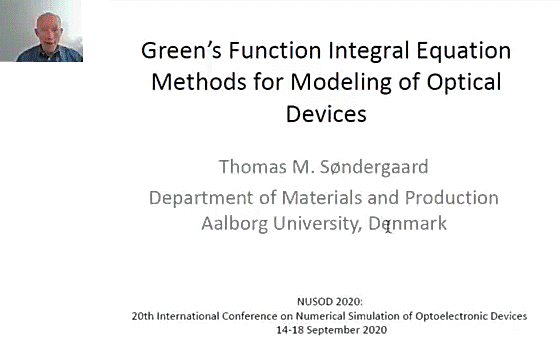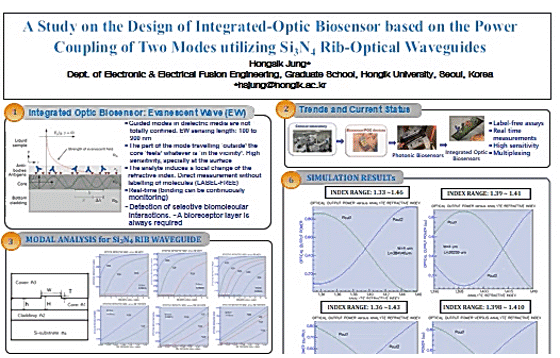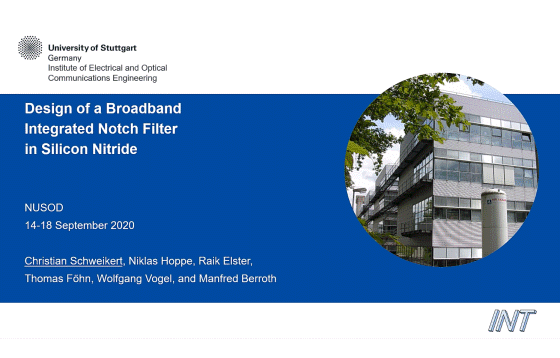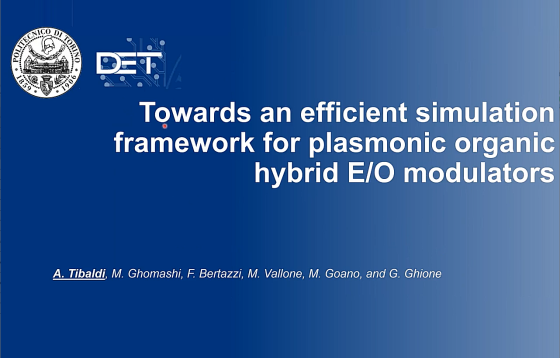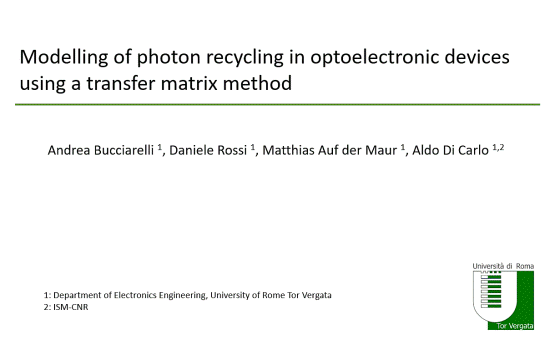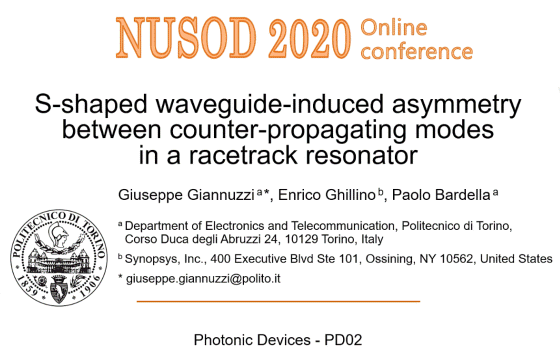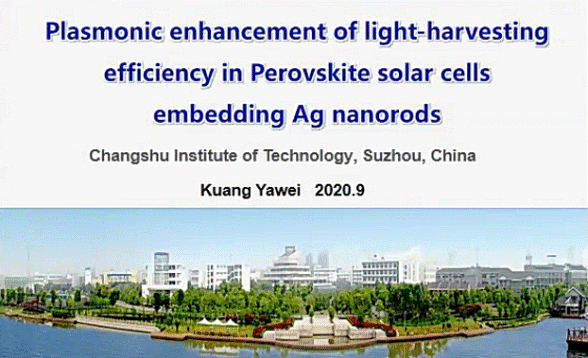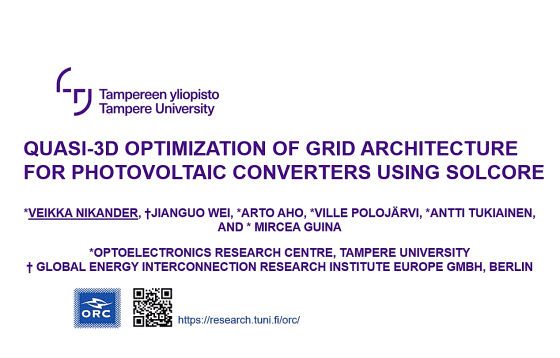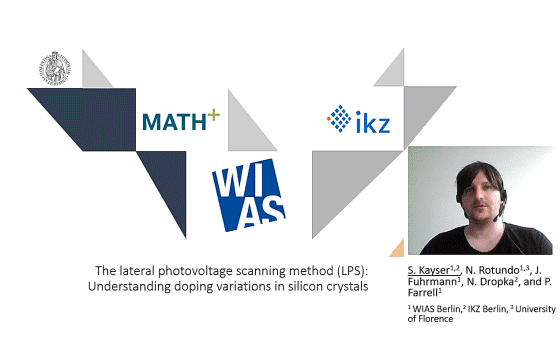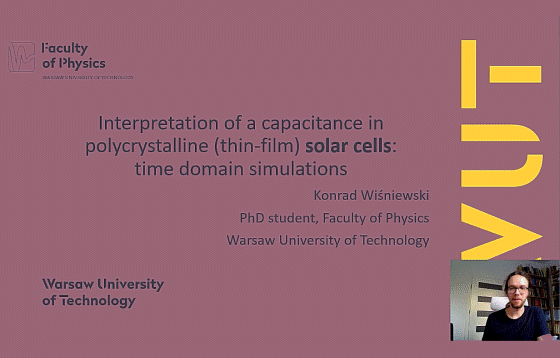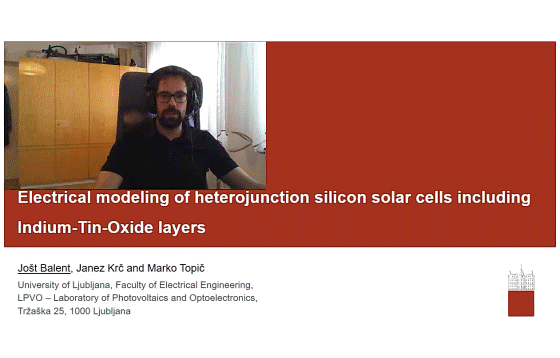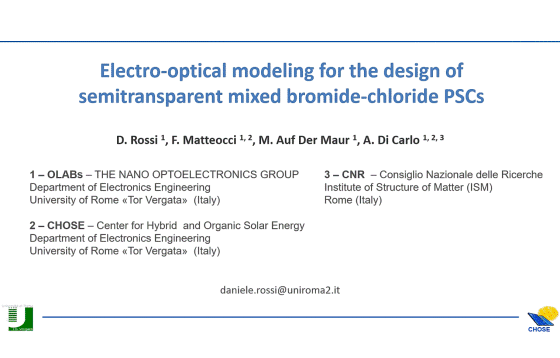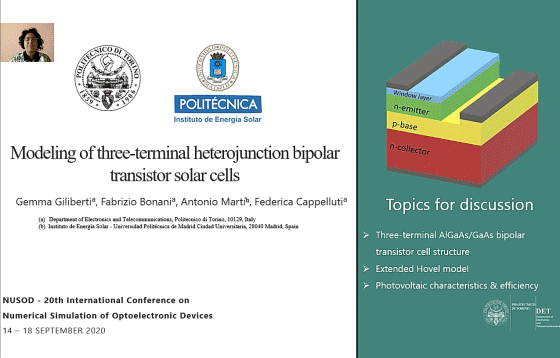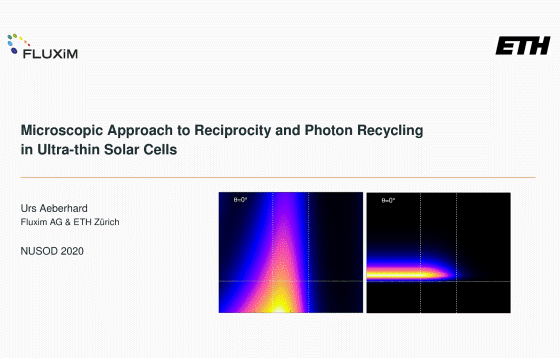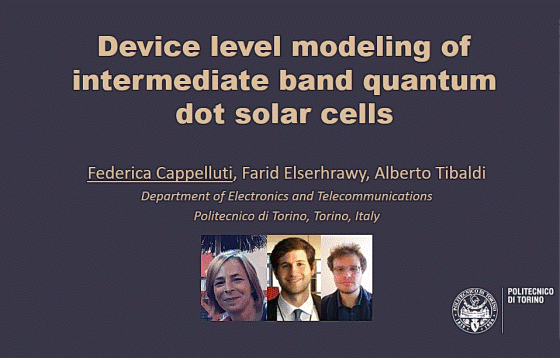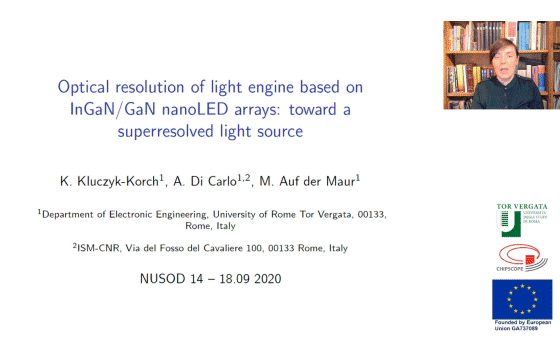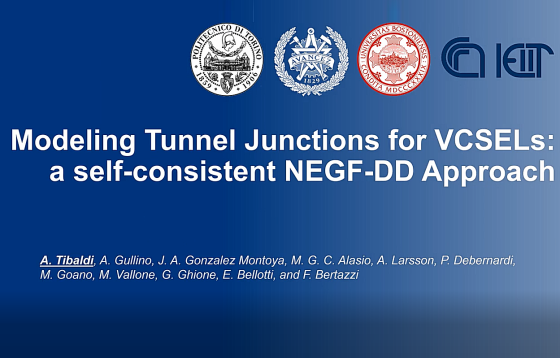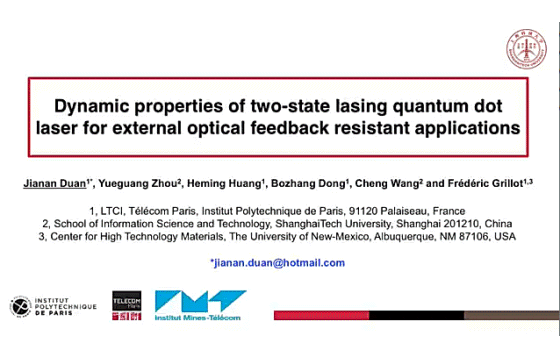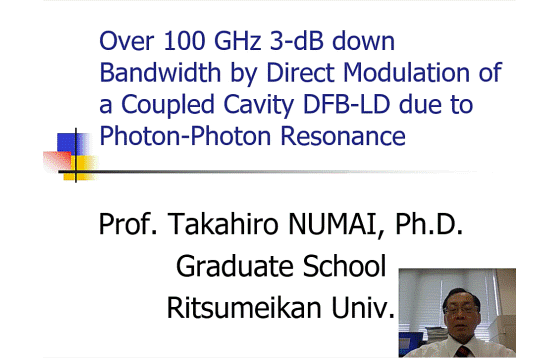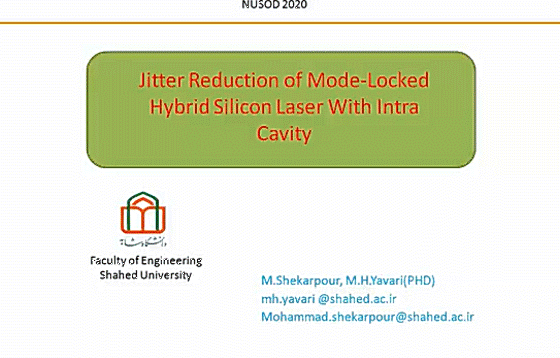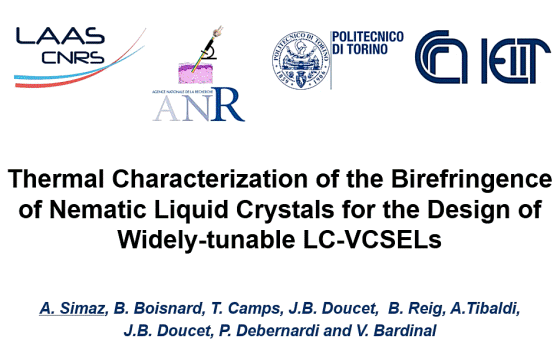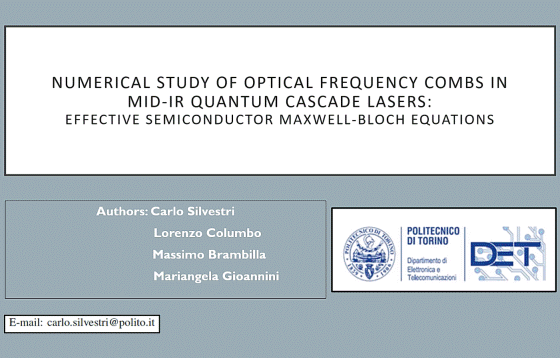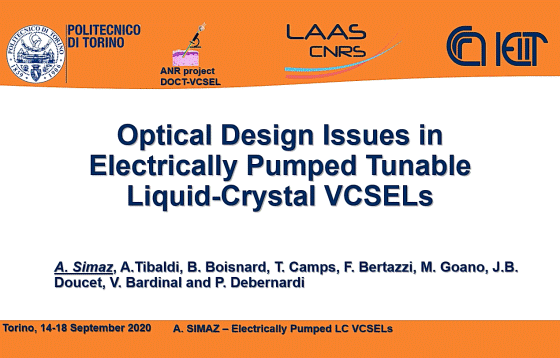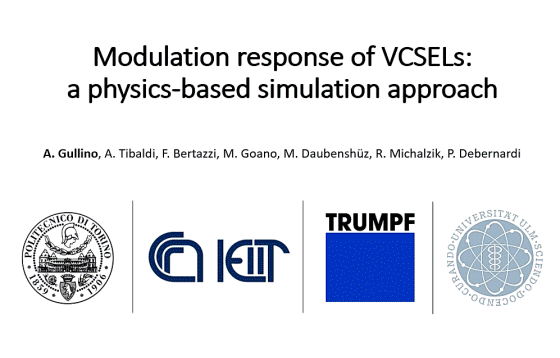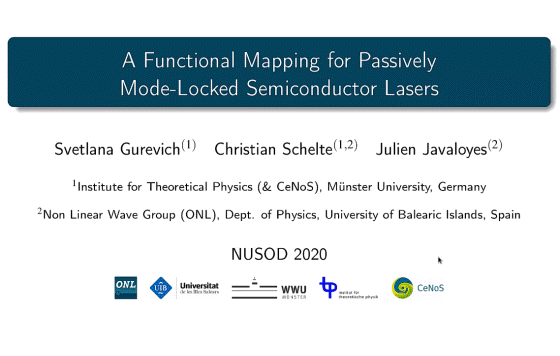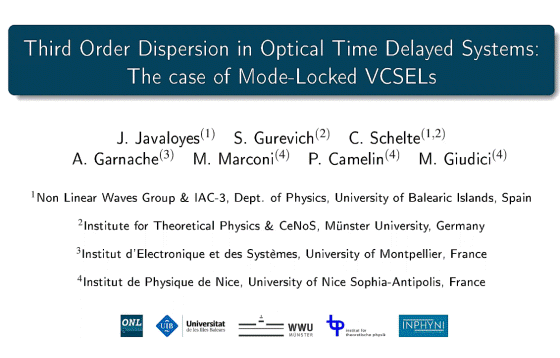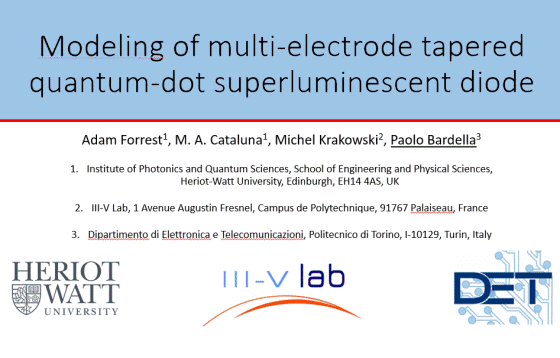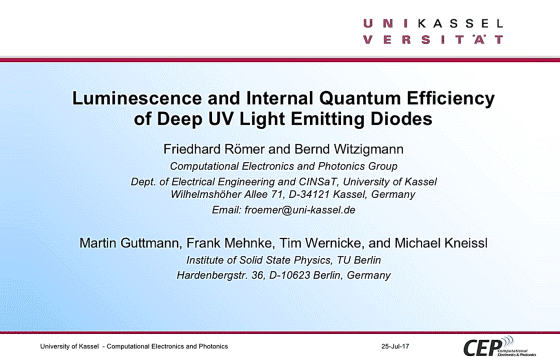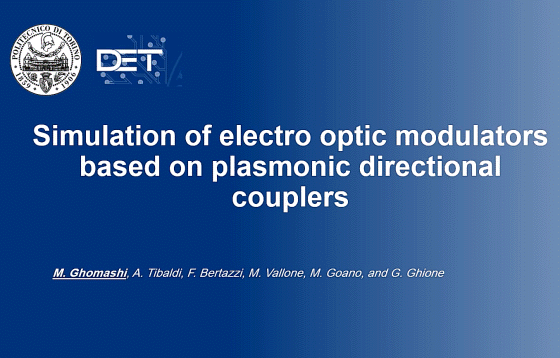


Green’s function integral equation methods are presented that can be applied for modeling of optical devices in cases where the problem can be formulated as a scattering problem. The methods are applied to study in three dimensions the effect of a cylindrical micro-lens on radiation emitted from a THz photoconductive antenna, and for studying the […]
PD06–A Study on the Design of Integrated-Optic Biosensor based on the Power Coupling of Two Modes utilizing Si3N4 Rib-Optical Waveguides
We proposed an integrated-optical biosensor configuration that operates at a wavelength of 0.63 μm based on the evanescent-wave and lateral two-mode power coupling of Si3N4 rib-optical waveguides formed on a Si/SiO2/Si3N4/SiO2 multilayer thin films. The coupling between the two propagating modes in the sensing region produces a periodically repeated optical power exchange along the propagation. […]
PD05–Design of a Broadband Integrated Notch Filter in Silicon Nitride
A broadband integrated notch filter, using the silicon nitride (Si3N4) platform, is presented. It achieves an extinction ratio (ER) of 60 dB and a full width at half maximum (FWHM) of 10 nm at the central wavelength (CW) 785 nm. The main filter components are Bragg gratings (BGs). For separating the occurring reflections from the […]
PD04–Towards an efficient simulation framework for plasmonic organic hybrid E/O modulators
Due to the large computational resources required, with CPU times of the order of several days, full-wave optical simulators can be hardly exploited for the modeling and optimization of plasmonic organic hybrid electro/optic modulators. With the aim to drastically reduce such complexity, in this work we present a divide-et-impera strategy reducing the number of FDTD […]
PD03–Modelling of photon recycling in optoelectronic devices using a transfer matrix method
In this work we present a generalized transfer matrix method to study the effect of the photon recycling on the performance of solar cells. Photon recycling increases the charge carrier concentration in solar cells, resulting in an increase of the open circuit voltage (Voc). The model is based on the transfer matrix method (TMM), taking […]
PD02–S-shaped waveguide-induced asymmetry between counter-propagating modes in a racetrack resonator
Ongoing progress in photonic integrated circuits necessitates the integration of semiconductor ring lasers (SRLs) with high performance and predictable behavior, which can be achieved when the symmetry of the SRL, which supports both clockwise and counterclockwise beam propagation, is unbalanced through loss mechanisms inside the resonator. In this work, numerical simulations were carried out on […]
SC10–Plasmonic enhancement of light-harvesting efficiency in Perovskite solar cells embedding Ag nanorods
Perovskite solar cells have attracted great attention in recent years due to its advantageous features including low production cost. Incorporation of plasmonic metal nanocrystals is a promising approach for broadening and enhancing the light harvesting of Perovskite solar cells. In this paper, we report a facile and versatile route to tune the photoresponse of perovskite […]
SC09–Quasi-3D Optimization of Grid Architecture for Photovoltaic Converters Using Solcore
Numerical study of metal front contacts grid spacing for photovoltaic (PV) devices is presented with application to PV converter of relatively small size. The model is constructed based on the open source Solcore Python library. A three-step-process is developed to create a hybrid quasi-3D model. The optimal grid spacing was simulated at different temperatures to […]
SC08–The lateral photovoltage scanning method (LPS): Understanding doping variations in silicon crystals
The lateral photovoltage scanning method (LPS) can be used to detect undesired impurities which appear in silicon crystals during growth. Our goal is to make a digital twin of the LPS method. To this end, we replace inflexible blackbox code with a physics preserving finite volume discretization, confirming three theoretical results via a new simulation […]
SC07–Interpretation of a capacitance in polycrystalline solar cells: time domain simulations
In this work, we presented simulations of capacitance of polycrystalline solar cells using time-dependent calculations based on the finite element method. Our starting point was capacitance transient measurements of thin-film CIGS solar cells, which to this day, after twenty years of investigations, do not have the correct theoretical description. We showed, that there exists a […]
SC02–Analysis and optimization of perovskite-silicon tandem solar cells by full opto-electronic simulation
We present a comprehensive opto-electronic simulation framework for the computational analysis and optimization of perovskite-silicon tandem solar cells, consisting of a combination of a multiscale optical model for the simultaneous consideration of interference in thin coatings and scattering at textured interfaces with a mixed electronic-ionic drift-diffusion transport model that captures the peculiarities of the geometries […]
SC06–Electrical modeling of heterojunction silicon solar cells including Indium-Tin-Oxide layers
In this contribution we performed opto-electrical simulations of heterojunction silicon (HJ Si) solar cell with Indium-Tin-Oxide layers included in simulations as front and rear contacts. Two-dimensional numerical simulations using Sentaurus TCAD software were carried out. We studied the effect of defect state density in p- and n-type hydrogenated amorphous silicon layers on device performance. Rigorous […]
SC04–Electro-optical modeling for the design of semitransparent mixed bromide-chloride PSCs
UV-selective absorbing perovskites have attracted significant interest due to their potential applications in innovative fields, such as building integration photovoltaics. This appeal arises from the possibility to tune the bandgap by simply varying their crystal composition. In this work we present electro-optical simulations to study the effect of Cl doping in MAPb(Br1-xClx)3 based semi-transparent solar […]
SC05–Modeling of three-terminal heterojunction bipolar transistor solar cells
Three-terminal solar cells exploiting the heterojunction bipolar transistor structure combine the advantages of independently connected tandem cell architectures – suboptimal gaps, high resilence to spectral variations and to radiation damage – with a simple monolithic structure, since they do not need tunnel junctions. In this work, we study this novel device concept by means of […]
SC03–Microscopic approach to reciprocity and photon recycling in ultrathin solar cells
In contrast to their bulk counterparts, ultrathin solar cells exhibit bias-dependent optical properties. This has severe implications for the validity of conventional opto-electronic reciprocity relations. We review the predictions of this phenomenon from quantum-kinetic theory and discuss the experimental confirmation, as well as the extension of the theoretical framework for the rigorous assessment of photon […]
SC01–Device level modeling of intermediate band quantum dot solar cells
Among many material candidates for next-generation solar cells, quantum dots offer unique opportunities. Aiming to maximally harness their nanoscale bandgap engineering, in this work we outline a multiscale, multiphysics modeling approach for the device level simulation of quantum dot solar cells. Examples of experimental validation are discussed, emphasizing the potential of light trapping techniques towards […]
LED01–Optical resolution of light engine based on InGaN/GaN nanoLED arrays: toward a superresolved light source
We present the optical simulations of a novel illumination source based on nanoLED arrays for the possible application in superresolved microscopy. We are simulating the images of various gold nanoparticle arrangements collected by the proposed nanoillumination microscope. The images are then analysed in order to understand the capabilities and limitations of the microscope.
LD04–Modeling Tunnel Junctions for VCSELs: A Self-Consistent NEGF-DD Approach
In this work we investigate carrier transport in tunnel junctions for vertical-cavity surface-emitting lasers by a novel self-consistent simulation framework for semiconductor quantum devices. Based on a Poisson-drift-diffusion foundation, in this approach quantum features are described through a nonequilibrium Green’s function formalism. The simulator is validated through a comparison with experimental results.
LD10–Dynamic properties of two-state lasing quantum dot laser for external optical feedback resistant applications
This work investigates the dynamics of two-state quantum dot lasers through semi-analytically solving a set of rate equations. Simulations reveal that the occurrence of excited state lasing reduces the damping factor of the laser while increases the linewidth enhancement factor associated to the ground state transition. These results are in good agreement with the experimental […]
LD09–Over 100 GHz 3-dB down Bandwidth by Direct Modulation of a Coupled Cavity DFB-LD due to Photon-Photon Resonance
This paper reports on 3-dB down bandwidth of 110.6 GHz by direct modulation of a coupled cavity DFB-LD with phase-shifted/uniform gratings due to photon-photon resonance when the injected current is 3.5 times the threshold current.
LD08–Jitter Reduction of Mode-Locked Hybrid Silicon Laser With Intra Cavity Filter
We study the influence of the intra-cavity ring on dynamics, phase noise and timing jitter of a long-ring-cavity colliding pulse mode-locked laser using a delay differential equation (DDE) model. The results of dynamic show that the intra-cavity filter can suppress harmonics of 2 GHz cavity. We also find a reduction of phase noise and timing […]
LD07–Thermal Characterization of the Birefringence of Nematic Liquid Crystals for the Design of Widely-tunable LC-VCSELs
In this work, the thermo-optical properties of nematic liquid crystals are investigated through localized reflectance spectra measurements performed on a tunable LC-filter. The final aim is to insert such LC in the cavity of a tunable VCSEL device, in which local self-heating due to optical or electrical pumping must be taken into account. We demonstrate […]
LD06–Numerical Study of Optical Frequency Combs in mid-IR Quantum Cascade Lasers: Effective Semiconductor Maxwell-Bloch Equations
In this paper a theoretical model based on Effective Semiconductor Maxwell-Bloch Equations (ESMBEs) is proposed for the description of the dynamics of a multi-mode mid-Infrared (mid-IR) Quantum Cascade Laser (QCL) in Fabry Perot (FP) configuration, in order to investigate the spontaneous generation of frequency combs in this device. In agreement with recent experimental results our […]
LD05–Optical Design Issues in Electrically Pumped Tunable Liquid-Crystal VCSELs
In this work we investigate a tunable 850nm laser based on a hybrid combination of a liquid crystal micro-cell and a half GaAs VCSEL. The target application is optical coherence tomography. The inherent tolerances of the hybrid technology, the presence of metals in the cavity and the need for a pure extraordinary mode lasing make […]
LD03–Modulation response of VCSELs: a physics-based simulation approach
A preliminary study of the dynamic behaviour of a GaAs/AlGaAs 850 nm VCSEL is presented, with the focus on the small-signal analysis and in particular on the optical amplitude modulation response. Simulations are performed with our in-house quantum-corrected one-dimensional drift-diffusion code D1ANA, updated to perform the AC analysis. The -3 dB cutoff frequency of the […]
LD02–A Functional Mapping for Passively Mode-Locked Semiconductor Lasers
We present a modern approach for the analysis of passively mode-locked semiconductor lasers that allows for efficient parameter sweeps and time jitter analysis. It permits accessing the ultra-low repetition rate regime where pulses become localized states. The analysis including slow (e.g. thermal) processes or transverse, diffractive dynamics becomes feasible. Our method bridges the divide between […]
LD01–Third Order Dispersion in Optical Time Delayed Systems: The case of Mode-Locked Vertical External-Cavity Surface-Emitting Lasers
Time-delayed dynamical systems materialize in situations where distant, point-wise, nonlinear nodes exchange information that propagates at a finite speed. However, they are considered devoid of dispersive effects, which are known to play a leading role in pattern formation and wave dynamics. We show how dispersion may appear naturally in delayed systems and we exemplify our […]
LED03–Modeling of multi-electrode tapered quantum-dot superluminescent diode
We introduce a rate equation based numerical model suitable for the description of the wide spectral asymmetry experimentally observed at the two facets of multi-electrode tapered superluminescent diode based on Quantum Dot material. Numerical simulations carried out with this model were able to quantitatively reproduce the behavior of a two-section SLD and explain the reported […]
LED02–Luminescence and Internal Quantum Efficiency of Deep UV Light Emitting Diodes
Deep ultraviolet (DUV) light emitting diodes (LED) made of Aluminium Gallium Nitride (AlGaN) are increasingly considered as light sources for medical as well as material processing applications. Recent research on AlGaN DUV LEDs focuses on the enhancement of the efficiency. The efficiency of AlGaN LEDs is limited by a low hole injection efficiency and TM-polarized […]
NM05–Simulation of electro optic modulators based on plasmonic directional couplers
In this paper, a new concept and geometry are proposed for plasmonic modulators, whose operation is based on the coupling between two plasmonic slots. An electro-optic polymer is exploited as an active material, and the device can be implemented within a Silicon Photonics platform. The device operates at 1550nm wavelength, typical of data center or […]

